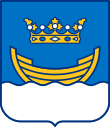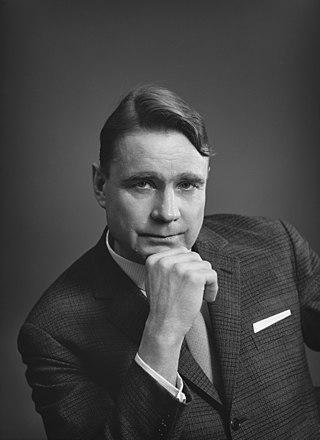
Mauno Henrik Koivisto was a Finnish politician who served as the ninth president of Finland from 1982 to 1994. He also served as the country's prime minister twice, from 1968 to 1970 and again from 1979 to 1982. He was also the first member of the Social Democratic Party to be elected as President of Finland.

The president of the Republic of Finland is the head of state of Finland. The incumbent president is Alexander Stubb, since 1 March 2024. He was elected president for the first time in 2024.
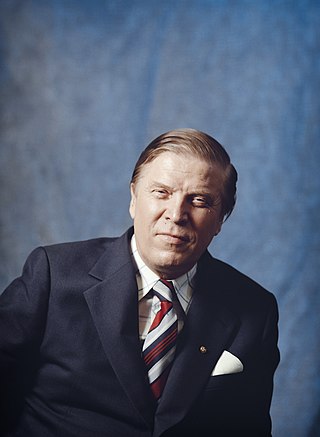
Johannes Virolainen was a Finnish politician and who served as 30th Prime Minister of Finland, helped inhabitants of Karelia, opposed the use of alcohol and created Mandatory Swedish in Finnish basic schools.
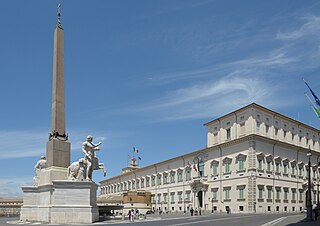
The Quirinal Palace is an historic building in Rome, Italy, one of the three current official residences of the President of the Italian Republic, together with Villa Rosebery in Naples and the Tenuta di Castelporziano, an estate on the outskirts of Rome, some 25 km from the centre of the city. It is located on the Quirinal Hill, the highest of the seven hills of Rome in an area colloquially called Monte Cavallo. It has served as the residence for thirty popes, four kings of Italy and twelve presidents of the Italian Republic.

The Grand Kremlin Palace is a building in the Moscow Kremlin. For much of the 19th century, it served as the official residence of the Russian emperor in Moscow. Designed by a team of architects under the management of Konstantin Thon, the palace was intended to emphasise the greatness of Russian autocracy.
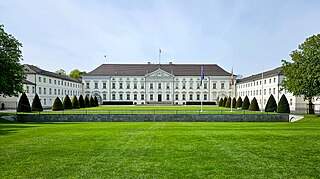
Bellevue Palace, located in Berlin's Tiergarten district, has been the official residence of the president of Germany since 1994. The schloss is situated on the banks of the Spree river, near the Berlin Victory Column, along the northern edge of the Großer Tiergarten park. Its name – the French for "beautiful view" – derives from its scenic prospect over the Spree's course.

The Alexander Palace is a former imperial residence near the town of Tsarskoye Selo in Russia, on a plateau about 30 miles (48 km) south of Saint Petersburg. The Palace was commissioned by Empress/Tsarina Catherine II in 1792.

Mäntyniemi is one of the three official residences of the President of Finland, besides the Presidential Palace and the summer residence Kultaranta. Mäntyniemi was finished in 1993. Five Finnish presidents have lived there: Mauno Koivisto, Martti Ahtisaari, Tarja Halonen, Sauli Niinistö and Alexander Stubb.

Meilahti is a neighbourhood of Helsinki between Mannerheimintie and a bay named Seurasaarenselkä. Most of the houses in Meilahti were built in the 1930s and 1940s. Meilahti is home to over 6700 people. Meilahti is the location of Mäntyniemi, official residence of the President of Finland, as well as Kesäranta, the official residence of Prime Minister of Finland. Near Mäntyniemi is the former presidential residence, Tamminiemi, which is today a museum dedicated to president Urho Kekkonen.

Kultaranta is the summer residence of the president of Finland. It is in the district of Kultaranta on the island of Luonnonmaa, in Naantali. The granite manor house is surrounded by 560,000 square metres (6,027,790 sq ft) of park, belonging to the property.

Independence Day of Finland is a national public holiday, and a flag flying day, held on 6 December to celebrate Finland's declaration of full independence from the Russian Empire when the Bolsheviks took power in late 1917.

Tamminiemi is a villa and house museum located in the Meilahti district of Helsinki, Finland. It was one of the three official residences of the President of Finland, from 1940 to 1982. From 1956, until his death in 1986, it served as the residence of President Urho Kekkonen. Since 1987, it has been the Urho Kekkonen Museum. Tamminiemi is located in a park by the sea. Its floor area is about 450 square metres (4,800 sq ft); living quarters comprise the first two floors while the third floor is dedicated to office space.

The Presidential Mansion in Athens, Greece, is the official residence of the president of the Hellenic Republic. It served previously as the Royal Palace, until the abolition of the monarchy by the 1973 referendum.

The Presidential Palace in Nanjing, Jiangsu, China, housed the Office of the President of the Republic of China from 1927 until the capital was relocated to Taipei in 1949. It is now a museum called the China Modern History Museum. It is located at No.292 Changjiang Road, in the Xuanwu District of Nanjing.
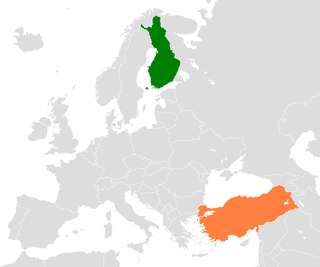
Finland–Turkey relations are foreign relations between Finland and Turkey. Finland has an embassy in Ankara and an honorary consulate general in Istanbul and other honorary consulates in Adana, Alanya, Antalya, Belek, Bodrum, İzmir, and Kayseri. Turkey has an embassy in Helsinki. Both countries are full members of the Council of Europe, the Organisation for Economic Co-operation and Development (OECD), the Organization for Security and Co-operation in Europe (OSCE), North Atlantic Treaty Organization (NATO), and the Union for the Mediterranean. Also Finland is an EU member and Turkey is an EU candidate. Turkey did not support Finland's accession to NATO until March 2023, but accepted its participation.
The Note Crisis was a political crisis in Soviet–Finnish relations in 1961. The Soviet Union sent Finland a diplomatic note on October 30, 1961, referring to the threat of war and West German militarization and proposing that Finland and the Soviet Union begin consultations on securing the defence of both countries, as provided for in the Finno-Soviet Treaty of 1948. The note coincided with the detonation of the Tsar Bomba, the most powerful nuclear test in history, and followed close on the heels of the Berlin Crisis and Bay of Pigs Invasion.

The Hôtel d'Estrées is a hôtel particulier, a type of large townhouse of France, at 79 rue de Grenelle in the 7th arrondissement of Paris. It is the residence of the Ambassador of the Russian Federation to France. It was designed by Robert de Cotte, architect of King Louis XIV, and built between 1711 and 1713 for Madeleine-Diane de Bautru de Vaubrun, the Duchesse d'Estrées (1668-1753). After belonging to several owners, it was purchased by the Russian government in 1863 and became the Russian Embassy. Both Czar Alexander II of Russia and his grandson, Nicholas II, stayed in the residence when they visited Paris. In 1977 the Russian Embassy was moved to another building, and the Hotel became the residence of the Ambassador. It is now classified as a historic monument of France.

The Independence Day Reception is an annual event organised by the President of Finland at the Presidential Palace in Helsinki on 6 December, Finland's Independence Day. Invitations are sent to all members of parliament and other representatives of the national and municipal governments, the ambassadors to Finland, representatives of NGOs, important business people, and people who distinguished themselves during the year in the arts, sports, sciences, and other fields.

Hotel Marski is a hotel opened 1962 on Mannerheimintie 10 in Helsinki, Finland.
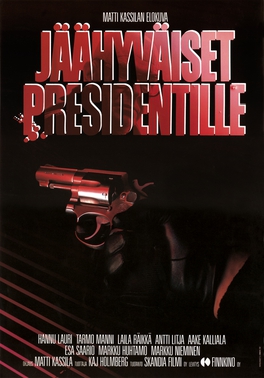
Farewell, Mr. President is a 1987 Finnish action thriller film directed by Matti Kassila and starring Hannu Lauri. It tells the story of a disgruntled waiter planning to assassinate the Finnish President. The film is based on a 1979 thriller novel of the same name by Pentti Kirstilä. Unlike contemporary Finnish films, the film is a thrilling film strongly influenced by post-classic Hollywood films.

































